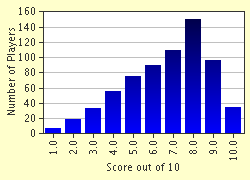Quiz Answer Key and Fun Facts
1. Which leader, seeing the French on the verge of collapse and the British army pushed out of Europe, was keen to seize whatever he could in the North Africa?
2. On June 11th 1940, the day after Italy declared war on France and Britain, which nations declared war on Italy?
3. Which Italian officer was nicknamed 'The Butcher'?
4. North Africa saw no action when Italy declared war, in fact it seemed to many that that Italy was indulging in bravado. However, the British and Commonwealth troops set about making things very difficult for the numerically superior enemy. In fact, the figures were amazing. Of these four - air power, heavy artillery, tank and manpower - there was only one in which the Allies had numerical superiority. Which was it?
5. The North African campaign saw many small battles and conflicts end in Allied victory. The Italian army was no match for the dogged determination of the British and Commonwealth forces. The skill and knowledge of the ANZACS (Australian and New Zealand forces) blasted Italian morale. In the ANZACs the British had first-rate, dependable forces. December 9th 1940 saw the British attack Italian positions in Western Egypt, which signalled the beginning of the end for Italian hopes of gaining the victory Mussolini wanted so badly. Which two generals carried out a five day assault that forced the Italian army retreat back to Libya?
6. January 17th 1941 saw a pivotal situation occur. Infantry of the Australian 19th Brigade and 7th Armoured Support Group, with the 11th Hussars probed ahead from victory at El Adem airfield in Libya. They reached a strategic port 800 miles from Tripoli and threw a cordon that was going to be very difficult to breach. This port was to become a famous siege. Where was it?
7. North Africa saw some quite amazing feats achieved by the tiny British and Commonwealth force. In the space of six weeks, this force fought its way across 200 miles (320km) of harsh terrain, taken by assault two powerful and heavily manned Italian fortifications and took many prisoners. Between January 5th 1941 and February 7th 1941 how many prisoners were taken by the British and Commonwealth forces?
8. Tank warfare played a massive role in the North African campaign of 1940-41. It was the one single factor in the Italian defeat that no-one had envisaged due to the harsh conditions of the desert. The Allies had two pieces of machinery that caused extensive damage, whilst the Italian relied solely on one model. The Rolls Royce A/C fought against the Fiat M13/40, but what other piece of machinary played a major role in the campaign?
9. What was the significant event that took place on February 12th in Tripoli, that heralded the next phase of the North African Campaign?
10. The stunning defeats Italy had suffered at the hands of the Allies gave the Germans much work to do in North Africa. Taking back as many fortresses and ports as possible would require very well planned campaign. Hitler chose a general who he thought was equal to this daunting task. The man in question was a tactical genius with a keen eye for enemy mistakes and plenty of cunning that enabled him to capitalise on them. What nickname was given to him?
Source: Author
doomed
This quiz was reviewed by FunTrivia editor
bloomsby before going online.
Any errors found in FunTrivia content are routinely corrected through our feedback system.

